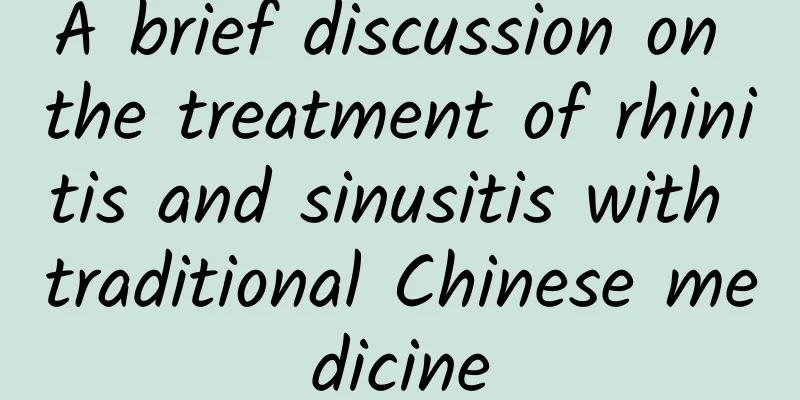A brief discussion on the treatment of rhinitis and sinusitis with traditional Chinese medicine

|
In the treatment of common nasal diseases such as allergic rhinitis, sinusitis, and chronic rhinitis, in addition to the role of traditional Chinese medicine syndrome differentiation and treatment, the promotion of disease prevention and care methods also accounts for a large proportion. There are also unique Chinese medicine external treatment methods, which often achieve the purpose of rapid effects. This diverse and flexible method combination makes Chinese medicine treatment of common nasal diseases highlight its advantages. Common external treatments for nasal diseases include nasal fumigation, nasal washing, nasal drops, nasal coating, external application, acupoint patch therapy, nasal plugging, acupuncture, intranasal acupuncture, sphenopalatine ganglion acupuncture, buried needle therapy, acupoint thread embedding, acupoint injection, Chinese medicine burning and rubbing therapy, and moxibustion. (1) Nose fumigation It is generally used for children, pregnant women and other people who are difficult to accept or cannot accept other external treatments. It is used for nasopharyngeal carcinoma, nasal vestibulitis, atrophic rhinitis and other diseases that require fumigation treatment with dry nasal cavity, pain, and more crusts as the main manifestations. Commonly used medicines include honeysuckle, forsythia, cicada shell, cicada herb, mint and other wind-dispelling and detoxifying Chinese medicines. The method is to put the medicine in cold water, bring it to a boil over high heat, then simmer for about 15 minutes. After it has cooled down to a suitable temperature, use the steam to fumigate your nose. Try to inhale through your nose and exhale through your mouth. Do this 2 to 3 times a day, each time for 10 to 20 minutes is best. (2) Nasal washing method It is generally applicable to everyone except those with obvious nasal obstruction and those with a history of otitis media. Different medications are used according to the nature of the disease. For example, Huanglian Jiedu Decoction is often used as the main prescription for sinusitis, and drugs for dispersing wind and cold are often used as the main prescription for allergic rhinitis. After normal decoction, let it cool and take the supernatant. The patient slightly lowers his head forward, turns 45 degrees to the side, opens his mouth and says "ah" or "open", while using a nasal rinser to slowly squeeze the liquid medicine into the upper nostril, allowing the liquid medicine to pass through the nasal cavity and flow out of the other nostril. Alternate between the two sides, once a day. If operating for others, they must be able to cooperate well before using it, to avoid causing otitis media or tracheitis. (3) Nasal drops It is suitable for all kinds of nasal diseases. Use special medicated oil or liquid to drip into the nose. The method is to lie flat, suspend the head in the air or raise the shoulders, tilt the neck back, and drip the medicine after the nostrils are facing upwards. 1-2 drops on each side. After dripping the medicine, pinch the nose for a short time to promote absorption, and then turn the head back to the normal position. 1-2 times a day. (4) Nose painting method Suitable for people with dry nasal cavity. Dip the head of a clean cotton swab into a thin layer of special medicated oil or ointment, and apply it evenly to the nasal vestibule, where the nose hair grows, 1 to 6 times a day. (5) External application It is suitable for patients with wind-cold nasal congestion or nasal furuncle, as well as rosacea. For wind-cold nasal congestion, boil the medicine for dispelling wind and opening the orifices into a Chinese medicine liquid, dip a small towel in it and wring it until no water drips, then apply it to the nose and face to achieve the purpose of warming and dispelling cold and opening the orifices. Patients with rosacea or nasal carbuncle can use external application of Chinese decoctions that can clear away heat, detoxify, reduce swelling and disperse nodules to achieve the effect of reducing swelling, relieving pain, dispersing nodules and discharging pus. (6) Acupoint application therapy Depending on the purpose of treatment, different drug combinations are selected and applied to the corresponding acupoints, which can respectively achieve the purposes of benefiting the nose, clearing the orifices, warming the yang and dispersing the cold, and guiding the fire back to the origin. For example, using drugs that can clear the orifices and refresh the mind to make medicine cakes, and applying them to Yingxiang, Shangyingxiang, Yintang, Dazhui and other acupoints is suitable for patients with obvious nasal congestion; using drugs that warm the yang and dispel cold, warm the meridians and dredge the collaterals, and dispel phlegm and promote qi to apply them to the back Shu acupoints, which can dispel cold and stop cough, stop sneezing and open the orifices, and also have the effects of health care and health preservation; using drugs that warm the middle and regulate qi, replenish fire and help yang to apply them to Sanyinjiao, Yongquan and other acupoints, which can play the role of guiding fire back to the origin, extinguishing wind and calming the mind. Select 2 to 6 acupoints each time, or more than ten acupoints for application, 0.5 hours to 4 hours for sensitive skin, 4 hours to 8 hours for those who tolerate it, once a day. (7) Nasal plugging method Use a clean cotton swab to dip into special medicine powder or ointment or liquid medicine to plug the nose. It is generally used for patients with sinusitis, allergic rhinitis, and nasal polyps. It plays the role of clearing the orifices and draining pus, and removing mucus and raising yang. One nostril can be used in the morning and the other in the afternoon. Make an "ah" sound while plugging the nose to avoid choking and coughing. 20 minutes to 1 hour each time is best. Sneezing, runny nose, a small amount of nosebleed, etc. may occur after plugging the nose, which are all normal phenomena. (8) Acupuncture, intranasal acupuncture, sphenopalatine ganglion acupuncture The effect is more obvious for patients with nasal congestion and affected sense of smell. Severe cases can be treated with acupuncture once a day or every 3 days, chronic cases can be treated once a week, and 5 to 7 times is a course of treatment. Pregnant women and those who are sensitive to pain should use it with caution. (9) Embedded Needle Method It is suitable for children with chronic rhinitis, allergic rhinitis, and sinusitis. It can dispel wind, open the orifices, reduce swelling and stop snoring. It is generally used on Yingxiang, Shangyingxiang, Yintang, Fengchi, Feishu and other acupoints. It is replaced every 24 hours. It can be used for 3 consecutive days during the attack period and once a week during the chronic period. (10) Acupoint Catgut Embedding Acupoint thread embedding therapy is based on acupuncture theory. It uses needles and medicated threads to stimulate meridians, balance yin and yang, harmonize qi and blood, and adjust internal organs in the acupoints to achieve the purpose of treating diseases. Generally, special disposable medical devices are used to implant absorbable carrier catgut (which can be absorbed by itself in about 15 days) into the Yingxiang acupoint and other corresponding acupoints. The catgut produces a slow, gentle, lasting and benign "long-acting needle sensation effect" on the acupoints in the body, achieving the effect of "deep insertion and long-term retention to cure stubborn diseases". Treatment every 20 to 30 days can avoid the trouble and pain of daily acupuncture. It is suitable for various chronic and stubborn diseases as well as for people who are short on time and afraid of the pain of acupuncture. (11) Acupoint injection therapy Acupoint injection therapy, also known as "water injection", is a method of treating diseases by injecting Chinese and Western medicines into relevant acupoints. It is suitable for more stubborn nasal diseases. (12) Chinese medicine cauterization Use corrosive drugs, such as javanica oil, to rub on the nasal hillock, inner Yingxiang and other parts of the nasal cavity to shrink the nasal concha, desensitize and reduce swelling. It is suitable for patients with allergic rhinitis and mild nosebleeds. (13) Moxibustion Using moxa as the main material, or adding a small amount of pungent, warm, fragrant and dry medicinal powder, wheat grain moxibustion, moxa stick moxibustion or thunder and fire moxibustion are used for local or systemic treatment, which has the effects of warming the meridians and dredge collaterals, raising yang and lifting the sunken, promoting qi and activating blood circulation, removing cold and dampness, reducing swelling and dispersing nodules, and can also be used for health care. It is more suitable for patients with deficiency-cold allergic rhinitis. Traditional Chinese medicine has many external treatment methods for nasal diseases, and the above are only some of the commonly used ones. In clinical applications, they can often be used alone or in combination, but the specific choice of external treatment method still needs to be decided by the doctor based on the condition. |
<<: Metformin is expected to become a safe and reliable new weight loss drug
Recommend
What to eat during menstruation to lose weight
Many people say that women lose weight best durin...
Normal abdominal pain in early pregnancy
Gynecologists indicate that in the early stages o...
Is it normal to have white and pastey vaginal discharge?
The popularization of reproductive health knowled...
What are the benefits of drinking black sesame paste for girls?
When we go shopping in the supermarket, black ses...
How to repair pelvic floor muscles
For many female friends, childbirth will cause ce...
What supplements are good to take after miscarriage?
For female friends, abortion is not a strange wor...
Why does my period not come after IUD insertion?
Many contraceptive measures will cause certain ha...
Do you understand these "distress signals" sent by breasts?
Recently, a 36-year-old woman in Beijing was diag...
What is a tube top?
For female friends, tube tops must be familiar to...
Two bars means pregnancy?
The pregnancy test strip is used to test the earl...
What is the reason for a plus sign in urine protein in pregnant women
Urine protein in pregnant women is a very common ...
The reason why the first fetus vomits but the second fetus does not
Women should be the happiest during this stage of...
How many days after the due date is normal?
We all know that doctors will calculate the due d...
AARP: Are social networking sites a friend or foe to families? – Data infographic
People of different ages have different acceptanc...
What are the nutritional values of stewed pork ribs with tea tree mushrooms? How to stew pork ribs with tea tree mushrooms
Agrocybe aegerita is a kind of mushroom food that...









